Coping Strategies
Embracing Calm: Key Benefits Of Practicing Stillness

Guess what? Half the time, our brains are off on their own little adventures, hopping from thought to thought like a monkey from tree to tree. Yep, snagging some peace and quiet in our jam-packed days feels like a game of hide and seek. But here’s a secret: mastering the art of stillness might just be the golden ticket to feeling awesome.
Practicing stillness, whether through meditation, mindfulness, or deep breathing exercises, can help quiet the mind and create a sense of peace and tranquility in your daily life. In a world filled with noise and distractions, learning to embrace stillness is a powerful tool to navigate the chaos and reconnect with yourself.
So, let’s explore the key benefits of practicing stillness and discover how it can help you embrace calmness amidst the busyness of life.
Key Takeaways:
- Practicing stillness offers numerous benefits for our mental, physical, and emotional well-being.
- Embracing stillness can reduce stress, improve focus, enhance emotional regulation, and foster a deeper connection with ourselves and the world around us.
- Activities such as meditation, mindfulness, and deep breathing exercises are powerful tools to cultivate stillness in our lives.
- Starting small and creating a calm space dedicated to stillness can help incorporate this practice into our daily routine.
- By embracing stillness, we can experience the transformative power of peace and tranquility.
The Art of Stillness: A Practice for Tranquility
The art of stillness is not just an absence of movement, but a skill or art form to be actively embraced and cultivated. It involves finding moments of silence, reflection, and mindfulness in the midst of a noisy world. By practicing stillness, we can slow down, disconnect from distractions, and find a sense of inner calm and clarity.
Amidst the hustle and bustle of modern life, the art of stillness offers a sanctuary of peace and tranquility. It invites us to pause, breathe, and be fully present in the moment. In our quest for constant productivity and achievement, we often overlook the power of stillness. However, by deliberately seeking moments of silence and practicing mindfulness, we can nourish our souls, rejuvenate our minds, and cultivate a deeper connection to ourselves and the world around us.
Practicing stillness is an intentional act that requires commitment and practice. It is not about forcing our minds into a state of emptiness, but rather about observing our thoughts without judgment and allowing them to pass by like clouds in the sky. It is about immersing ourselves in the present moment, fully embracing the stillness that resides within us and around us.
The art of stillness is a practice that enables us to find tranquility amidst the chaos, to uncover clarity within the noise, and to discover wisdom in the silence.
Through the art of stillness, we can develop a deep sense of self-awareness and self-compassion. By creating sacred spaces within our lives dedicated to stillness, whether it’s through meditation, journaling, or simply sitting in quiet contemplation, we can reconnect with ourselves on a profound level. In these moments of tranquility, we can explore our innermost thoughts, desires, and fears, gaining insights and perspectives that may have eluded us in the frenetic pace of everyday life.
In the midst of stillness, inspiration often arises. It is in these moments of quiet reflection that we can tap into our creativity, uncover new possibilities, and find solutions to the challenges we face. The art of stillness opens doors to fresh perspectives and allows us to approach life with renewed clarity and focus.
To illustrate the transformative power of stillness, consider the following table:
| Benefits of Practicing Stillness | Description |
|---|---|
| Reduces stress | By disconnecting from distractions and finding moments of stillness, we can reduce the harmful effects of stress on our minds and bodies. |
| Enhances focus and concentration | Through the practice of stillness, we can sharpen our focus and improve our ability to concentrate on tasks at hand. |
| Promotes emotional well-being | Stillness allows us to cultivate emotional intelligence, regulate our emotions, and find a sense of inner peace. |
By incorporating stillness into our daily lives, we can experience the profound benefits it offers. The art of stillness is not a destination, but a lifelong journey. It requires patience, persistence, and an open heart and mind. As we continue to practice stillness, we unlock its transformative power and come to realize that tranquility is not something external to be sought, but an inherent quality that resides within each one of us.
Stress Reduction Through Stillness
Constant exposure to stress can take a toll on both our physical and mental well-being. The demands of daily life, work pressures, and various responsibilities can leave us feeling overwhelmed and drained. However, there is a powerful tool that can help us combat stress and find inner peace: practicing stillness.
Through practices like meditation and deep breathing exercises, we can disconnect from the chaos around us and create moments of calm and tranquility. Research has shown that these stillness techniques have a profound impact on our stress levels, reducing the production of stress hormones and inducing a state of relaxation.
By devoting time to practicing stillness, we give our nervous system a much-needed break. Our bodies and minds can rejuvenate, recharge, and find the balance necessary to navigate life’s challenges with greater resilience.
This image illustrates the concept of stress reduction through stillness. It serves as a visual reminder of the peace and serenity that we can cultivate by embracing moments of stillness in our lives.
Mindfulness Benefits
“In today’s fast-paced world, practicing stillness is a vital tool for stress reduction. The ability to disconnect, find inner calm, and restore balance is essential for our overall well-being.”
Practicing stillness also allows us to develop mindfulness, a state of focused awareness on the present moment. By training our attention to the here and now, we can let go of worries about the past and anxieties about the future. This mindful presence helps us experience life more fully, appreciate the simple joys, and find gratitude in each day.
| Benefits of Practicing Stillness |
|---|
| Reduction in stress hormones |
| Promotion of relaxation and calm |
| Improved focus and concentration |
| Enhanced self-awareness |
| Increased resilience in the face of challenges |
This table provides a concise overview of the benefits of practicing stillness. By incorporating stillness into our lives, we can experience these positive changes and cultivate a greater sense of well-being.
So, let’s make a conscious effort to embrace stillness and prioritize our mental and emotional health. By nurturing moments of tranquility and practicing mindfulness, we can reduce stress, find inner calmness, and truly thrive in our daily lives.
Enhancing Mental Clarity
The busyness of life can often leave us feeling mentally scattered and overwhelmed. Our minds become cluttered with endless to-do lists, distractions, and information overload. It’s crucial to find ways to clear the mental fog and regain focus. One powerful method to enhance mental clarity is by practicing stillness.
Through the practice of stillness, we create space for clear thinking and sharpen our ability to concentrate. By intentionally cultivating moments of silence and calm, we allow our minds to settle, gaining clarity and perspective amidst the chaos.
When we practice stillness, we give ourselves the gift of uninterrupted time to reflect, process thoughts, and recharge. This intentional pause enables us to step back from the constant stimulation and demands of daily life, giving our minds the chance to reset and rejuvenate.
“In the midst of movement and chaos, keep stillness inside of you.” – Deepak Chopra
During stillness practice, we engage in techniques such as meditation, deep breathing exercises, or mindfulness. These practices have been proven to boost cognitive function, improve problem-solving abilities, and enhance decision-making skills.
Benefits of Practicing Stillness for Mental Clarity:
- Clear thinking: Stillness allows us to declutter our minds, enabling thoughts to flow more freely and clearly.
- Focus and concentration: By practicing stillness, we train our minds to stay present and pay attention to the task at hand, increasing our ability to concentrate.
- Improved problem-solving: Stillness helps us approach challenges with a calm and centered mindset, allowing us to find creative solutions more effectively.
Achieving mental clarity through stillness is a transformative journey. It requires consistent practice and patience, but the benefits are well worth the effort. As we cultivate the habit of stillness, we create a harmonious balance in our minds, allowing us to navigate life’s challenges with greater ease and awareness.
Fostering Emotional Regulation
Emotions are a natural part of being human, and they play a significant role in shaping our experiences and interactions. However, at times, emotions can become overwhelming and lead to impulsive reactions that we may later regret. That’s where practicing stillness comes in.
Practicing stillness allows us to acknowledge and observe our emotions without judgment. By creating a safe space within ourselves to sit with our feelings, we can cultivate emotional intelligence and develop healthier ways of managing our emotional states.
“In the midst of chaos, taking a moment of stillness offers the opportunity to connect with our deepest emotions and respond rather than react.” – Dr. Maya Johnson
Engaging in activities such as meditation, deep breathing exercises, or simply finding a quiet moment to be present can help us foster emotional regulation. Through stillness, we can develop awareness of our emotional triggers and patterns, allowing us to respond to situations with clarity and balance rather than being carried away by intense emotions.
Research has shown that practicing stillness and mindfulness benefits our emotional well-being. It encourages the development of emotional resilience, a skill that helps us bounce back from challenging situations and maintain a sense of inner calmness. By regularly engaging in stillness practices, we can improve our ability to regulate our emotions, leading to more balanced and harmonious interactions both within ourselves and with others.
Embracing stillness as a means of fostering emotional regulation can have a profound impact on our overall well-being. It provides us with the tools to navigate the ups and downs of life with greater ease, enhancing our emotional intelligence and promoting healthier emotional responses. By regularly incorporating stillness practices into our lives, we can find inner peace and cultivate emotional balance.
| Benefits of Fostering Emotional Regulation through Stillness | Description |
|---|---|
| Increased self-awareness | Practicing stillness allows us to tune into our emotions and gain a deeper understanding of ourselves. |
| Enhanced emotional intelligence | By observing our emotions without judgment, we can develop greater insight into our emotional responses and improve our ability to navigate them. |
| Improved emotional regulation | Regularly engaging in stillness practices allows us to regulate our emotions more effectively, leading to healthier emotional responses. |
| Reduced impulsivity | By cultivating stillness, we can learn to respond rather than react impulsively to emotional triggers and stressful situations. |
| Greater emotional resilience | Practicing stillness can help us build emotional resilience, enabling us to bounce back from challenging situations with grace and equanimity. |
By embracing the power of stillness and practicing emotional regulation, we can transform our relationship with our emotions and create a greater sense of balance and well-being in our lives.
Exercising Stillness in a Busy World
Many of us lead lives filled with constant stimuli from technology, work, and social obligations. Our schedules are packed, and the demands on our time and attention seem never-ending. While this busyness can give us a sense of purpose and achievement, it also comes with its own set of challenges.
In the midst of our busy lives, it is crucial to take breaks and find moments of stillness. Practicing stillness allows us to step back, create space for introspection, and increase self-awareness. It offers a respite from the chaos and helps us restore balance in our lives.
| Benefits of Exercising Stillness in a Busy World | How to Incorporate Stillness into Your Life |
|---|---|
|
|
|
|
“In the midst of movement and chaos, keep stillness inside of you.” – Deepak Chopra
By incorporating stillness into our busy lives, we can develop a deeper connection to ourselves and the world around us. It allows us to pause, reflect, and recharge both physically and mentally. Through practicing stillness, we can find moments of calm amidst the hustle and bustle, leading to a greater sense of well-being and inner peace.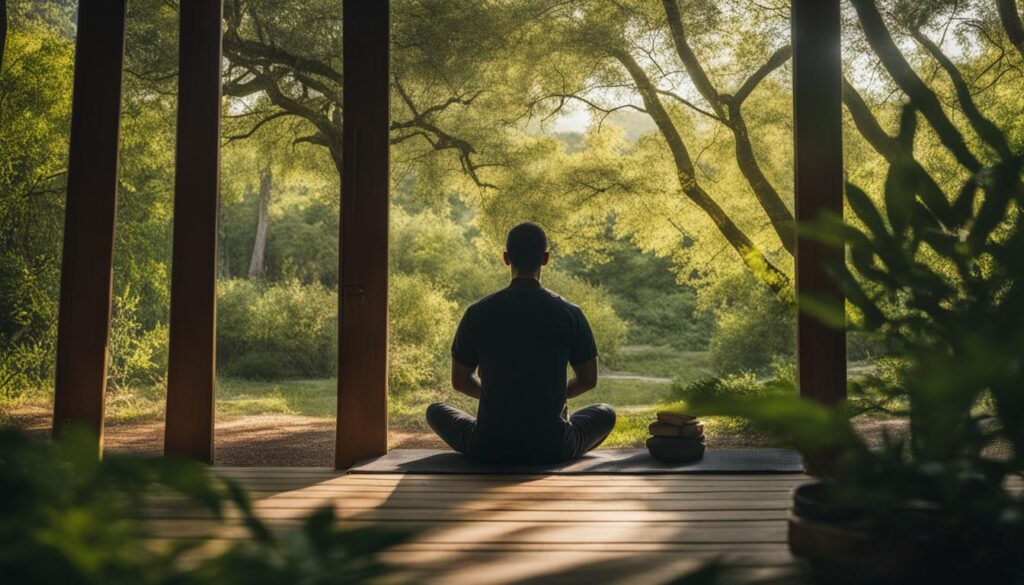
Starting Small: Short Sessions of Stillness
When it comes to practicing stillness, you don’t need to start with lengthy meditation sessions or complex mindfulness exercises. In fact, beginning with short sessions is a great way to ease into the practice and make it a regular part of your routine.
By dedicating just 5 to 10 minutes each day to stillness, you can gradually cultivate a sense of tranquility and peace within yourself. Starting small allows you to build consistency and momentum, making it easier to integrate stillness into your busy lifestyle.
During these short sessions, find a quiet and comfortable space where you can focus without distractions. Close your eyes, take deep breaths, and embrace the present moment. Allow your mind to settle and your body to relax.
As you become more comfortable with short sessions, you can gradually increase the duration at your own pace. The goal is not to rush or overwhelm yourself, but to find a balance between stillness and the demands of your daily life.
Remember, practicing stillness is a journey, and every small step contributes to your overall well-being. Embrace the power of short sessions and discover the profound impact they can have on your inner peace and clarity of mind.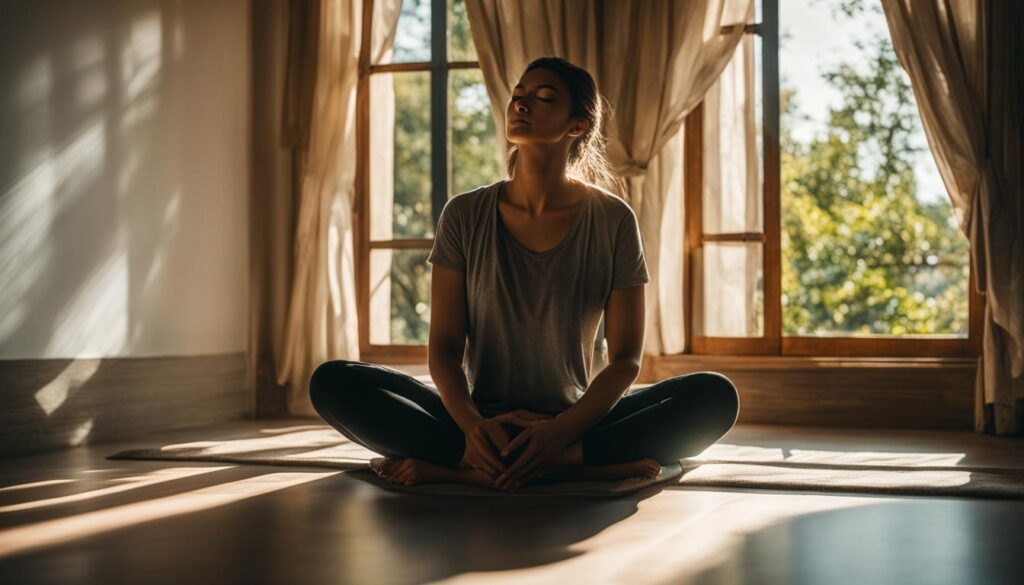
| Benefits of Starting Small | Reasons to Embrace Short Sessions |
|---|---|
| 1. Eases the transition into stillness practice | 1. Builds consistency and momentum |
| 2. Reduces feelings of overwhelm or resistance | 2. Fits easily into a busy lifestyle |
| 3. Helps create a habit of regular practice | 3. Allows for gradual increase in duration |
| 4. Cultivates mindfulness in short bursts | 4. Promotes a balanced approach to stillness |
Creating a Calm Space for Stillness
When it comes to practicing stillness, creating a calm space is essential. Designating a quiet and comfortable environment in your home or workplace can greatly enhance your ability to engage in deep introspection and mindfulness. Here are some tips for creating a serene environment that supports the practice of stillness:
- Find a dedicated space: Choose a specific area where you can retreat to, free from distractions and external noise. This could be a cozy corner in your room, a tranquil spot in your garden, or even a secluded park bench.
- Eliminate clutter: Clearing away physical clutter helps create mental clarity and promotes a sense of calm. Keep the space tidy and free from unnecessary items that may cause distractions or overwhelm.
- Add elements of nature: Nature has a soothing effect on our minds and bodies. Incorporate natural elements into your calm space, such as plants, stones, or a small water feature, to create a harmonious and grounding atmosphere.
- Set the ambiance: Consider lighting, temperature, and scent to create a peaceful ambiance. Soft lighting, a comfortable temperature, and calming aromas like lavender or eucalyptus can contribute to a tranquil atmosphere.
“Creating a calm space for stillness is like crafting a sanctuary for your mind and soul. It provides a nurturing environment where you can disconnect from the outside world and focus on inner peace and reflection,” says mindfulness expert, Dr. Emma Reid.
In this calm space, you can engage in various stillness practices, such as meditation, deep breathing exercises, or simply sitting in silence. It acts as a refuge, allowing you to find solace and reconnect with yourself, away from the chaos of daily life.
Creating a dedicated space for stillness is instrumental in establishing a consistent practice. It serves as a gentle reminder to prioritize self-care and mindfulness in your daily routine. Remember, your calm space doesn’t need to be extravagant or elaborate; what matters most is that it provides a serene and inviting environment where you can fully immerse yourself in the art of stillness.
Deep Breathing as an Entry Point to Stillness
When it comes to practicing stillness, deep breathing serves as an excellent entry point. By simply taking a few minutes each day to focus on our breath, we can begin cultivating a sense of calm and mindfulness. Deep breathing involves inhaling slowly and deeply through our nose, holding our breath for a moment, and gently exhaling through our mouth. As we engage in this deliberate and intentional act, we anchor ourselves in the present moment, allowing the noise and distractions of the world to fade away.
The beauty of deep breathing lies in its simplicity and accessibility. We carry the tool of our breath with us at all times, ready to be harnessed whenever we seek stillness. Whether it’s in the morning upon waking, during a hectic workday, or before bedtime, we can pause for a moment, close our eyes if it feels comfortable, and connect with the rhythm of our breath.
Deep breathing not only calms the mind but also has a profound impact on our physiology. As we inhale deeply, oxygen floods our cells, rejuvenating our bodies and minds. This influx of oxygen stimulates the parasympathetic nervous system, known as our “rest and digest” response, and counteracts the effects of the stress-inducing sympathetic nervous system.
The practice of deep breathing opens the door to greater self-awareness and introspection. It allows us to shift our focus away from external stimuli and turn our attention inward. With each inhale and exhale, we become attuned to our bodily sensations, thoughts, and emotions. This increased awareness fosters a state of mindfulness, where we observe the present moment without judgment.
As we establish a routine of deep breathing, we enhance our capacity to navigate life’s challenges with grace and equanimity. We develop a powerful tool that accompanies us through the ebb and flow of daily life, always accessible and capable of instantly bringing us back to a state of calm and presence.
“Deep breathing is the bridge that connects our outer world to the realm of stillness within us.”
Embrace the practice of deep breathing as your entry point to stillness. It requires nothing more than your breath and a few minutes of your time. Let us collectively harness the power of this simple yet transformative practice, anchoring ourselves in the present moment and cultivating a sense of calm and mindfulness in our lives.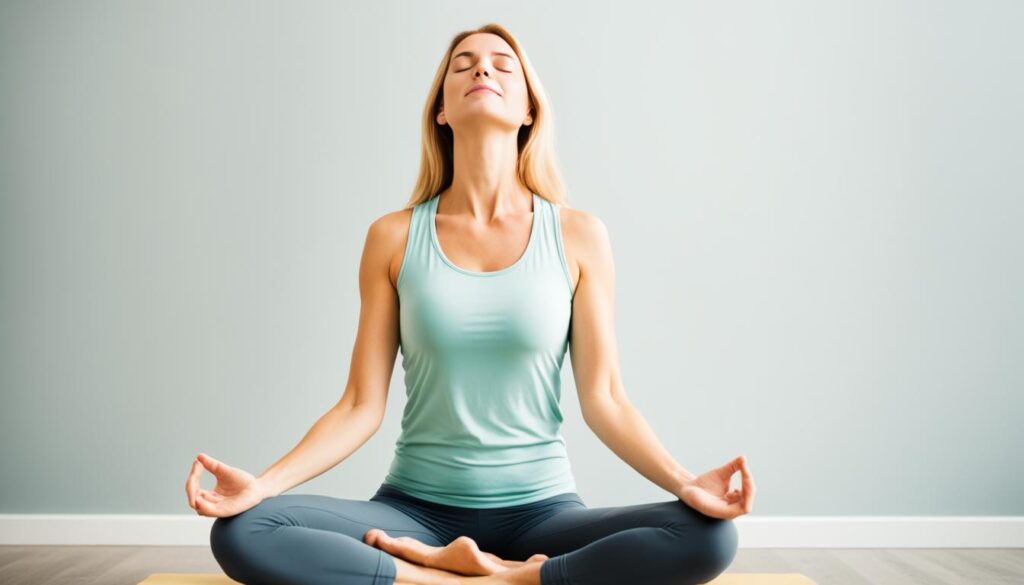
| Benefits of Deep Breathing as an Entry Point to Stillness |
|---|
| 1. Reduces stress and anxiety |
| 2. Enhances focus and mental clarity |
| 3. Promotes physical and mental relaxation |
| 4. Cultivates mindfulness and self-awareness |
| 5. Improves overall well-being and resilience |
Disconnecting from Technology for Stillness
In our digital age, it’s important to set aside specific times in the day to disconnect from digital devices. This allows us to establish a deeper connection with the present moment and reduce unnecessary distractions. By creating boundaries with technology, we can create more space for stillness and mindfulness.
Technology has become an integral part of our lives, constantly demanding our attention with notifications, emails, and social media updates. The constant influx of information can leave us feeling overwhelmed and disconnected from ourselves. Practicing stillness requires us to intentionally disconnect from technology and create moments of peace and tranquility.
“Disconnecting from technology allows us to reclaim our time and attention. It’s about creating a space where we can be fully present and engage with our inner thoughts and emotions.”
When we disconnect from technology, we free ourselves from the distractions that pull us away from the present moment. Instead of mindlessly scrolling through social media feeds or getting caught up in the latest news cycle, we can focus on the here and now. This break from technology allows us to cultivate a deeper sense of self-awareness and engage more fully in the activities that bring us joy and fulfillment.
Disconnecting from technology doesn’t mean completely abandoning it. It’s about finding a balance that works for us. We can start by setting aside designated times each day to turn off notifications, put our devices on silent, or even take short breaks from screens altogether. During these technology-free moments, we can practice stillness through meditation, deep breathing exercises, or simply being present in the moment.
Disconnecting from technology allows us to:
- Reduce distractions and increase focus
- Improve mental clarity and creativity
- Reconnect with our thoughts, emotions, and physical sensations
- Promote a greater sense of calm and inner peace
- Enhance our overall well-being and happiness
By disconnecting from technology and embracing stillness, we can create a healthier relationship with our devices and ourselves. It’s about finding balance in our fast-paced, technology-driven world and creating space for introspection and self-care.
Disconnecting from technology for stillness allows us to recharge and reconnect, leading to a more fulfilling and intentional life. So, let’s take a moment to unplug, breathe deeply, and embrace the tranquility that comes with stillness.
Embracing Walking Meditation
When we think of stillness, we often envision sitting in silence. However, stillness doesn’t always mean sitting still. Walking meditation is a powerful practice that allows us to integrate stillness into our active lives and cultivate mindfulness during everyday activities.
Walking meditation involves taking slow, deliberate steps and immersing ourselves in the present moment. It offers a unique opportunity to bring mindful movement into our practice of stillness. With each step, we focus our attention on the sensation of our feet touching the ground, the rhythm of our breath, and the gentle movements of our body.
This practice encourages us to become fully present in our body and surroundings, fostering a deep connection with the present moment. We can engage all our senses, feeling the warmth of the sun on our skin, the softness of the grass beneath our feet, or the cool breeze brushing against our face.
Walking meditation can be practiced anywhere, whether it’s in a beautiful park, a quiet neighborhood, or even indoors. It offers a refreshing break from our busy lives, allowing us to slow down and reconnect with ourselves and the world around us.

As we embrace walking meditation, we discover that the simple act of putting one foot in front of the other becomes a profound journey of self-discovery. It brings us back to our body, grounding us in the present moment and cultivating a sense of peace and calm.
So, let us incorporate walking meditation into our practice of stillness, embracing the mindful movement and the serenity it brings. The path awaits, inviting us to take each step with intention and awareness, as we continue on our journey of self-transformation.
The Profound Practice of Stillness
The art of stillness offers countless health and mindfulness benefits. By incorporating stillness into our lives, we can experience a profound transformation of the mind, body, and spirit. Through the practice of stillness, we can navigate the challenges of life with grace and find serenity amidst the chaos.
Clarity of Mind and Inner Peace
Practicing stillness allows us to quiet the mind and find a sense of clarity and focus. In moments of profound stillness, we can let go of racing thoughts and mental clutter, cultivating a calm and peaceful state of mind. With a clearer mind, we can approach tasks and decisions with greater clarity and intention.
A Deeper Connection to Ourselves and the World
When we practice stillness, we create space for self-reflection and introspection. This deepens our connection to ourselves, enabling us to become more in tune with our emotions, needs, and desires. Additionally, stillness opens us up to a deeper connection with the world around us, fostering a sense of interconnectedness and empathy.
By immersing ourselves in the present moment and cultivating mindfulness, we can engage fully in our experiences and relationships, enhancing our overall well-being. Through this profound practice, we can become more attuned to the beauty, joy, and abundance that surrounds us.
Embracing the Benefits of Mindfulness
Mindfulness is a cornerstone of practicing stillness. By intentionally focusing our attention on the present moment, we can cultivate a state of heightened awareness and presence. This, in turn, reduces stress, anxiety, and worry, promoting a greater sense of calm and contentment in our lives.
“In the midst of movement and chaos, keep stillness inside of you.” – Deepak Chopra
Enhancing Physical and Mental Well-being
The profound practice of stillness has far-reaching effects on our physical and mental health. Research has shown that practicing stillness can lower blood pressure, strengthen the immune system, improve sleep quality, and reduce symptoms of anxiety and depression.
| Physical Benefits | Mental Benefits |
|---|---|
| Reduces stress levels | Improves focus and concentration |
| Enhances relaxation response | Reduces symptoms of anxiety and depression |
| Improves cardiovascular health | Promotes emotional well-being |
| Boosts immune system | Fosters resilience and adaptability |
These benefits highlight the profound impact that stillness can have on our overall well-being and quality of life. By regularly incorporating stillness into our daily routines, we can cultivate a lasting sense of peace, balance, and harmony within ourselves and the world around us.
Tuning Into Your Physical Self
Practicing stillness is not just about finding calmness in your mind, but also about tuning into your physical self. By taking the time to bring awareness to your body, you can address any discomfort or minor issues before they escalate into larger problems that affect your overall well-being. When we practice stillness, we prioritize self-awareness and ensure that we are in tune with our physical needs.
Self-awareness plays a crucial role in maintaining our physical well-being. It allows us to recognize early signs of tension, fatigue, or pain and take appropriate measures to address these issues. By incorporating practices such as meditation or body scans into our stillness routine, we cultivate a deeper connection with our physical self.
“Tuning into your physical self opens the door to a wealth of valuable information about your body’s needs and limitations.”
Whether it’s noticing a tightness in our muscles, a headache, or irregular breathing, these physical cues guide us towards taking necessary actions. By paying attention to these signals, we can prevent the escalation of minor discomforts into more significant health issues. Tuning into our physical self allows us to make informed decisions about our well-being.
Practicing stillness can also help us develop a greater understanding of the mind-body connection. When we are present in the moment, we become more attuned to how our thoughts, emotions, and physical sensations intertwine. This awareness enables us to identify the impact of our thoughts and emotions on our physical well-being. We can then make intentional choices to cultivate a harmonious balance between our mental and physical selves.
Benefits of Tuning Into Your Physical Self:
- Early recognition of physical discomfort
- Prevention of minor issues turning into major health problems
- Enhanced mind-body connection
- Improved ability to make informed decisions regarding our well-being
By actively tuning into our physical self during moments of stillness, we empower ourselves to lead healthier and more balanced lives. Let us embrace the practice of stillness to cultivate self-awareness and ensure our physical well-being.
Note: Practicing stillness helps us tune into our physical self and cultivate self-awareness. By acknowledging and addressing any discomfort or minor issues, we can prevent them from developing into larger problems and maintain our overall well-being.
Easing Mental Health Symptoms
Engaging in stillness practices has been shown to have a positive impact on easing mental health symptoms. By incorporating deep breathing and moments of stillness into our daily routine, we can activate the parasympathetic nervous system, promoting relaxation and reducing symptoms of stress and anxiety.
When we take the time to observe our thoughts and become aware of negative and maladaptive ideas, we can begin to reframe them and replace them with more positive and adaptive thoughts. This process of reframing helps improve our emotional well-being and fosters a more optimistic outlook on life.
“Engaging in stillness practices can have a profound effect on our mental health. It allows us to create a sense of calm and space within ourselves, helping to alleviate symptoms of stress, anxiety, and depression.”
By practicing stillness and incorporating mindfulness techniques, we cultivate emotional well-being and develop the skills to better manage our emotions. This increased emotional regulation leads to a more balanced and harmonious way of being.
Mindfulness Meditation for Mental Health
One powerful stillness practice that has been widely studied and proven effective in easing mental health symptoms is mindfulness meditation. By intentionally focusing our attention on the present moment, we can cultivate a greater sense of awareness and mindfulness. This awareness allows us to respond to challenging situations with clarity and compassion, rather than reacting impulsively.
A recent study published in the Journal of Clinical Psychology found that mindfulness meditation significantly reduced symptoms of stress, depression, and anxiety, and improved overall psychological well-being.
| Mental Health Symptom | Percentage Reduction |
|---|---|
| Stress | 45% |
| Depression | 35% |
| Anxiety | 40% |
These findings highlight the potential of mindfulness meditation as a practical and accessible tool for easing mental health symptoms.

The Power of Stillness for Emotional Well-Being
Practicing stillness not only allows us to ease mental health symptoms but also fosters emotional well-being. By creating moments of stillness, we create space to process and understand our emotions more fully. We can observe our emotions without judgment or attachment, leading to greater self-awareness and emotional intelligence.
Through the practice of stillness, we learn to accept and validate our emotions, fostering a healthier relationship with ourselves and those around us. This increased emotional well-being ripples into all areas of our lives, improving our relationships, work performance, and overall satisfaction.
It is important to note that the practice of stillness is not meant to replace professional mental health treatment but can be used as a complementary tool to support our mental well-being.
Appreciating the Present Moment
Practicing stillness allows us to escape the grip of the past and the worries of the future. Instead, it invites us to fully embody the present moment, savoring its richness and beauty. By staying mindful and grounded in the here and now, we can cultivate a profound sense of appreciation for the simple joys and blessings that surround us.
In today’s fast-paced world, it’s easy to get caught up in the chaos and lose sight of the present moment. However, through the practice of stillness, we can train our minds to focus on the here and now, appreciating each passing moment as it unfolds.
“When you realize nothing is lacking, the whole world belongs to you.” – Lao Tzu
By adopting a mindset of mindfulness, we can shift our perspective and start noticing the small miracles that often go unnoticed. The warmth of the sun on our skin, the sound of laughter, the gentle rustling of leaves – these moments of beauty are all around us, waiting to be appreciated.
As we embrace the present moment, we become more attuned to our senses and aware of the precious details that often go unnoticed. Each moment holds its own unique essence, and by practicing stillness, we can fully immerse ourselves in the present, savoring its flavors, textures, and emotions.
“The present moment is filled with joy and happiness. If you are attentive, you will see it.” – Thích Nhất Hạnh
Let us take a moment to pause and appreciate the present moment. Close your eyes, take a deep breath, and observe the sensations within your body. Feel the rise and fall of your chest, the beating of your heart. Notice the sounds that surround you, the air against your skin. In this moment, there is a world of possibility and appreciation.
“The little things? The little moments? They aren’t little.” – Jon Kabat-Zinn
| Ways to Appreciate the Present Moment |
|---|
| Cultivate gratitude for the present moment. |
| Engage your senses by fully experiencing the present moment. |
| Acknowledge and embrace the beauty in the ordinary. |
| Practice mindfulness to stay grounded in the present. |
| Pause and reflect on the blessings in your life. |
By dedicating ourselves to the art of stillness, we can deepen our appreciation for the present moment and live each day with a renewed sense of wonder and gratitude.
Conclusion
The art of practicing stillness offers numerous benefits for our mental, physical, and emotional well-being. By embracing the power of stillness, we can reduce stress, improve focus and concentration, enhance emotional regulation, and cultivate a deeper connection with ourselves and the world around us. Incorporating stillness into our everyday lives can bring a sense of tranquility and inner peace amidst the noise and distractions of the modern world.
Practicing stillness allows us to slow down, step back, and create space for introspection. It provides us with an opportunity to tune into our physical selves, address any discomfort, and maintain our overall well-being. Furthermore, engaging in stillness practices can ease mental health symptoms and promote emotional well-being, allowing us to navigate life’s challenges with grace.
Let us embrace the art of stillness and experience its transformative power. By making time for stillness and cultivating moments of silence, we can appreciate the present moment, foster self-awareness, and develop a deeper connection to ourselves and the world around us. The benefits of practicing stillness are vast, enriching our lives with calmness, clarity, and a renewed sense of purpose.
What are the Key Benefits of Practicing Stillness for the Mind?
Practicing stillness has numerous benefits for exploring the mind’s benefits. It promotes mental clarity, reduces stress, and enhances self-awareness. By quieting the mind, individuals can achieve a deeper level of focus and concentration, leading to improved cognitive function and emotional well-being.
FAQ
What is the art of stillness?
The art of stillness refers to finding peace and cultivating moments of silence, reflection, and mindfulness in your life.
What activities are involved in practicing stillness?
Practicing stillness includes activities such as meditation, mindfulness, and deep breathing exercises.
What are the benefits of practicing stillness?
Practicing stillness offers numerous health and mindfulness benefits, including stress reduction, mental clarity, and emotional regulation.
How does practicing stillness reduce stress?
Practicing stillness, such as through meditation or deep breathing exercises, has been shown to reduce stress hormones and promote a sense of calm and relaxation.
How does stillness enhance mental clarity?
Practicing stillness can help improve mental clarity by creating space for clear thinking and focus.
How does stillness foster emotional regulation?
Engaging in stillness practices allows you to acknowledge and observe your emotions without judgment, fostering emotional intelligence and healthier ways of managing your feelings.
How can stillness be incorporated into a busy life?
Stillness encourages you to step back, create space for introspection, and increase self-awareness, even in the midst of a busy life.
How can I start practicing stillness?
Begin with short sessions, such as 5 to 10 minutes each day, and gradually increase the duration as you become more comfortable.
How can I create a calm space for stillness?
Designate a quiet and comfortable space in your home or workplace where you can practice stillness without distractions.
How can deep breathing help with stillness?
Deep breathing is an excellent entry point into stillness, as it can help you anchor yourself in the present moment and cultivate a sense of calm.
How can I disconnect from technology for stillness?
In our digital age, it’s important to set aside specific times in the day to disconnect from digital devices and create more space for stillness and mindfulness.
What is walking meditation?
Walking meditation is a form of active stillness where you take slow, mindful steps and focus on each movement and sensation in your body.
What are some of the profound benefits of practicing stillness?
The practice of stillness offers countless health and mindfulness benefits, including clarity of mind, inner peace, and a deeper connection to oneself and the world.
How does stillness benefit physical self-awareness?
Practicing stillness allows you to tune into your physical self and bring awareness to any discomfort or minor issues that could affect your mood and behavior.
How does stillness ease mental health symptoms?
Engaging in stillness practices can have a positive impact on mental health symptoms by promoting relaxation and improving emotional well-being.
How does stillness help in appreciating the present moment?
Practicing stillness enables you to avoid dwelling on the past or worrying about the future, fostering a deeper appreciation for the here and now.
Sarah’s voice is one of the first you’ll encounter at How Get Divorce, and it’s one you’ll come to trust. As a writer, she brings relatability and approachability to complex topics, making them understandable for everyone. As our Community Moderator, Sarah fosters a welcoming and supportive environment, encouraging open dialogue and connection among our members. Her ability to relate to others and moderate discussions makes her an integral part of our team and community.
Coping Strategies
5 Ways Adult Children Can Cope With Parents' Divorce
Wade through the complexities of navigating your parents' divorce with these five essential coping strategies, and discover how to find stability amidst the storm.
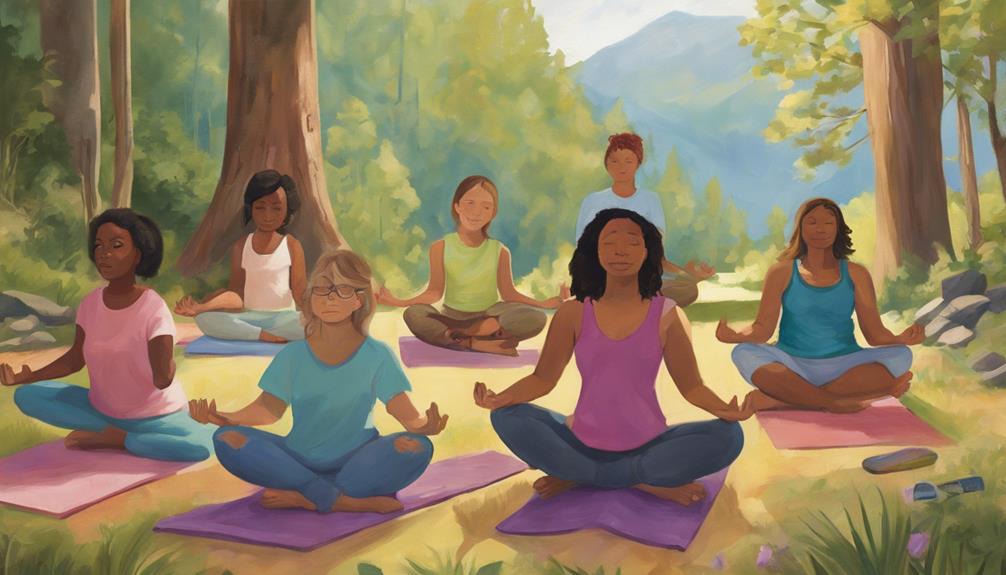
We all know that navigating our parents' divorce can feel like trying to sail through stormy waters without a compass. The choppy emotions and uncertainty can leave us feeling adrift.
However, there are ways to anchor ourselves amidst the turmoil. By setting clear boundaries, seeking professional support, maintaining open communication, finding healthy outlets for stress, and building a strong support network, we can weather this challenging time with resilience and grace.
Let's explore these strategies together and discover how they can help us navigate the storm of our parents' divorce.
Key Takeaways
- Establish emotional boundaries with parents to protect mental well-being.
- Seek therapy for processing emotions and developing coping strategies.
- Maintain open communication with parents to express needs and set boundaries.
- Find personal outlets for stress through activities like exercise and journaling.
Establishing Emotional Boundaries
Establishing emotional boundaries during your parents' divorce is crucial for maintaining your mental well-being and navigating your own feelings effectively. As adult children, it's essential to communicate assertively with your parents about what you can handle emotionally. By setting healthy boundaries, you can protect yourself from being overwhelmed by the details of their divorce. It's okay to express your needs clearly and respectfully, ensuring that you prioritize your mental well-being throughout this challenging time.
When you create emotional boundaries, you give yourself the space to process your own emotions separate from your parents' situation. This allows you to navigate your feelings in a way that's healthy and constructive, without feeling burdened by their divorce. By being assertive about what you can handle and how you wish to be involved, you maintain a sense of autonomy and control over your emotional well-being. Remember, it's important to take care of yourself while supporting your parents through this process.
Seeking Therapy for Support

Therapy offers a safe and supportive environment for adult children to process their emotions and navigate the complexities of their parents' divorce. Seeking therapy can provide a vital outlet for expressing feelings and learning coping strategies to address the emotional challenges that arise.
Professional therapists offer guidance on processing the impact of the divorce, helping adult children develop healthy ways to deal with these effects. Through therapy, individuals can work on establishing boundaries, understanding their emotions, and improving communication post-divorce.
Engaging in therapy sessions can support adult children in building resilience and moving forward positively despite the challenges they face. It's essential to remember that seeking therapy is a proactive step towards healing and growth, offering valuable tools and insights to navigate the aftermath of parental divorce with strength and grace.
Communicating Openly With Parents
When navigating communication with parents post-divorce, fostering open dialogue can be key to expressing emotions and maintaining a healthy relationship. It's essential to communicate openly with our parents while setting boundaries to ensure that our needs are respected. By discussing our concerns calmly and without judgment, we can foster understanding and support within our family unit. Seeking help from friends, family, or professionals when facing communication challenges can provide valuable assistance during this transition. Remember, prioritizing self-care and mental well-being is crucial in these conversations to navigate the challenges that come with parental divorce. Below is a table summarizing key points to consider when communicating with parents post-divorce:
| Key Points |
|---|
| Express feelings openly |
| Set healthy boundaries |
| Seek support |
| Prioritize self-care |
| Communicate calmly |
Finding Personal Outlets for Stress
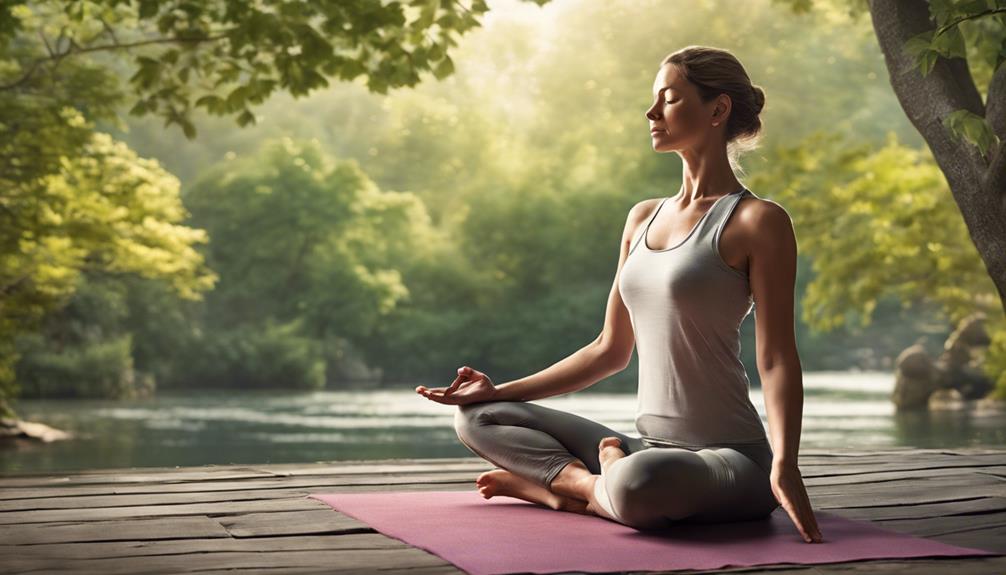
Navigating the emotions stemming from our parents' divorce can be overwhelming, but finding personal outlets for stress is crucial in maintaining our mental well-being and resilience. When faced with the emotional strain of our parents' divorce, it's essential to prioritize self-care and explore various avenues to alleviate stress. Here are some ways to find personal outlets for stress:
- Engage in stress-relieving activities: Incorporating exercise, meditation, or hobbies into our routine can help manage the emotional turmoil caused by the divorce.
- Seek support: Whether it's from friends, family, or a therapist, reaching out to others can provide a safe space to express our feelings and gain valuable perspectives.
- Journal your thoughts: Writing down our thoughts and emotions can serve as a therapeutic outlet for processing the impact of the divorce and fostering self-reflection.
- Participate in support groups: Connecting with other adult children of divorce in support groups can offer a sense of community and understanding during this challenging time.
Building a Support Network
To establish a strong foundation for coping with parental divorce, building a supportive network of understanding friends and family members is paramount.
When navigating the complexities of our emotions during this challenging time, seeking guidance from a therapist or counselor can provide a safe and non-judgmental space to process our feelings and gain professional support.
Additionally, joining support groups specifically designed for adult children of divorce can offer a sense of community and shared experiences, reminding us that we aren't alone in our journey.
Engaging in self-care activities such as exercise, meditation, or pursuing hobbies can also play a crucial role in promoting emotional well-being and reducing stress levels.
Frequently Asked Questions
How Do Adults Cope With Parents Divorcing?
We cope with parents divorcing by maintaining open communication, setting boundaries, seeking support, addressing concerns calmly, and prioritizing self-care. It's crucial to navigate this challenging time with understanding and care for ourselves.
How Can Adults Help Children Cope With Divorce?
We can support children coping with divorce by encouraging open dialogue, providing love and stability, seeking professional help if needed, maintaining routines, and shielding them from parental conflicts. Our role is crucial in helping them navigate this challenging time.
How Do You Cope With Divorce When You Still Love Him?
When we still love amidst separation, we honor our feelings and seek support to navigate the complex emotions. By setting boundaries, focusing on self-care, and embracing growth, we move forward with grace and resilience.
How Can I Help My Grown Daughter Through Her Divorce?
We can provide emotional support and encourage open communication with our grown daughter during her divorce. By helping her set boundaries, seek professional help if needed, and create a supportive network, we can assist her through this challenging time.
Conclusion
As adult children navigating our parents' divorce, it's important to remember that we aren't alone in this journey. One statistic that may surprise you is that over 1 million children experience their parents' divorce each year.
Let's continue to prioritize our mental well-being, seek support when needed, and remember that it's okay to lean on others during this challenging time. Together, we can navigate this difficult transition with strength and resilience.
Maya brings a wealth of experience in providing emotional support to individuals facing life’s challenges. Her contributions to How Get Divorce are characterized by empathy, understanding, and a profound sense of authority on matters of emotional well-being. Maya’s work is dedicated to ensuring that our community feels supported and understood, offering tools and advice to cope with the emotional aspects of divorce.
Coping Strategies
Coping With Loneliness After Divorce: a Step-By-Step Guide
Kicking off a transformative journey through loneliness after divorce, discover practical steps and self-discovery strategies that lead to healing and a new chapter in life.

Navigating the sea of loneliness post-divorce can feel like being adrift without a compass in uncharted waters.
However, with practical steps and a supportive approach, finding solace and rediscovering oneself is within reach.
As we explore the depths of coping mechanisms and self-discovery in the aftermath of divorce, let's uncover the transformative journey towards healing and embracing a new chapter of life.
Key Takeaways
- Acknowledge and process negative emotions without judgment for healing.
- Engage in social activities to build new connections and combat loneliness.
- Practice self-care and seek professional help for emotional well-being.
- Explore new interests and hobbies to rediscover identity and boost mood.
Understanding Post-Divorce Loneliness
In understanding post-divorce loneliness, it's important to recognize that this emotional experience can vary greatly among individuals. The impact of divorce on our emotional state is profound, and feelings of loneliness can be intensified by emotional abandonment experienced during the marriage.
Coping with post-divorce loneliness involves acknowledging and processing negative emotions without self-judgment. It's normal to feel a range of emotions during this time, and it's crucial to lean on a support system that includes friends and family. Building emotional resilience is key to navigating the challenges of post-divorce loneliness.
While the journey may feel isolating, remember that you aren't alone in this experience. By engaging in healthy coping strategies and surrounding yourself with a supportive network, you can begin to heal from the pain of divorce and gradually rediscover a sense of connection and belonging.
Building Social Connections

Let's strengthen our social connections after divorce by actively engaging in supportive communities and activities. Loneliness can feel overwhelming, but there are ways to combat it. Here are some practical steps to help you build social connections and find companionship during this challenging time:
- Joining Support Groups: Connecting with others who understand your feelings can provide immense comfort and validation.
- Engaging in Social Activities: Participating in events and activities can help you meet new people and form meaningful connections.
- Reconnecting with Old Friends and Family: Reaching out to trusted friends and family members can offer a sense of familiarity and support.
- Volunteering in Community Organizations: Giving back to the community not only reduces loneliness but also gives you a sense of purpose and fulfillment.
- Participating in Online Communities: Engaging in virtual support groups can provide valuable insights, advice, and a sense of belonging in a digital space.
Coping Strategies and Self-Care
Strengthening our coping strategies and prioritizing self-care are crucial steps in navigating the emotional challenges that come with loneliness after divorce. Engaging in self-care practices such as meditation, exercise, or journaling can nurture our emotional well-being, providing a sense of comfort during difficult times. Building a strong support system with friends, family, or support groups is essential in combating feelings of loneliness. Seeking professional help or therapy is a proactive step if these feelings become overwhelming or persistent.
Taking up new hobbies or activities can be a great way to distract ourselves, meet new people, and foster a sense of connection. By practicing gratitude daily and focusing on the positives in our lives, we can promote emotional resilience and well-being. Remember, it's okay to prioritize self-care and seek help when needed; these actions are vital in the journey towards healing and finding peace after a divorce.
Exploring New Interests and Hobbies

Exploring new interests and hobbies post-divorce can open doors to exciting opportunities for personal growth and fulfillment. It's a chance to shift your focus from the past to the present, embracing activities that bring joy and a sense of purpose. Here are some ways diving into new hobbies can benefit you:
- Find Fulfillment: Engaging in activities that you enjoy can provide a sense of fulfillment and accomplishment.
- Boost Your Mood: Trying new things can boost your mood and overall well-being, helping you navigate through challenging times.
- Create a Fresh Identity: Discovering new interests allows you to create a fresh identity and explore different aspects of yourself beyond your past relationship.
- Expand Your Social Circle: Exploring new hobbies can introduce you to like-minded individuals, expanding your social circle and providing a sense of community.
- Explore Yourself: Trying out new interests is a great way to explore different facets of your personality and interests, leading to personal growth and self-discovery.
Seeking Support and Community
Navigating the challenges of loneliness after a divorce can be eased by actively seeking out support and community resources. Joining a support group can provide a sense of belonging and understanding from individuals who are going through similar experiences. Additionally, seeking therapy or counseling post-divorce can offer professional guidance in coping with loneliness, helping you navigate your emotions more effectively.
Engaging in social activities and events is another effective way to combat feelings of isolation and build new connections. Building a strong support system with friends and family members can offer valuable emotional support and companionship during tough times. Participating in volunteer work or community service can also provide a sense of purpose and connection to others, reducing feelings of loneliness by allowing you to contribute positively to society.
Frequently Asked Questions
How Can I Manage Feelings of Guilt or Shame After My Divorce?
We manage feelings of guilt or shame after divorce by acknowledging our emotions, seeking support from loved ones or therapy, and focusing on self-compassion and growth. It's okay to feel this way; we're not alone.
Is It Common to Experience a Sense of Loss Over the End of My Marriage, Even if I Initiated the Divorce?
Absolutely, it's entirely normal to feel a sense of sorrow or separation after divorce, even if you initiated it. We, too, experienced this. Processing these emotions with care and support is crucial for healing.
What Are Some Ways to Navigate Awkward Social Situations or Interactions With Mutual Friends Post-Divorce?
Navigating awkward social situations post-divorce can be tough. We find that honesty, setting boundaries, and focusing on our well-being help. It's about being true to ourselves and surrounding ourselves with understanding friends.
How Can I Address Any Negative Self-Talk or Beliefs About Myself That May Have Developed During or After the Divorce?
Feeling down about ourselves post-divorce is common. We've been there. It's crucial to challenge those negative beliefs. Treat yourself as a dear friend, offering love and encouragement. Embrace your worth; you deserve it.
Are There Any Specific Resources or Support Groups Tailored to Individuals Going Through a Divorce Who Are Also Dealing With Loneliness?
Of course, there are tailored resources and support groups to help individuals navigating divorce and loneliness. These can provide comfort, understanding, and practical advice. Connecting with others in similar situations can make a significant difference in your journey.
Conclusion
As we navigate the challenging waters of post-divorce loneliness, let's remember that this feeling is temporary. By prioritizing self-care, building social connections, exploring new hobbies, and seeking support, we can gradually find our way to a fulfilling and happy life beyond divorce.
Remember, the journey may be tough, but with perseverance and support, we can emerge stronger and more resilient than ever before. Trust in the process and believe in your ability to overcome this obstacle.
Maya brings a wealth of experience in providing emotional support to individuals facing life’s challenges. Her contributions to How Get Divorce are characterized by empathy, understanding, and a profound sense of authority on matters of emotional well-being. Maya’s work is dedicated to ensuring that our community feels supported and understood, offering tools and advice to cope with the emotional aspects of divorce.
Coping Strategies
7 Ways Men Can Cope With Divorce
Journey through seven essential strategies for men to navigate the challenges of divorce and emerge stronger than ever.

As we journey through the turbulent seas of divorce, we frequently search for methods to stabilize our emotional health in the midst of chaos.
However, with careful consideration and strategic planning, there are seven key strategies that can help men not only survive but thrive post-divorce.
From redefining personal goals to fostering a strong support system, these coping mechanisms offer a roadmap to healing and growth in the aftermath of a significant life transition.
Key Takeaways
- Embrace change as a path to personal growth.
- Build a strong support system for emotional stability.
- Prioritize self-care and well-being during the transition.
- Seek professional counseling for guidance and coping strategies.
Acceptance and Embracing Change
Embracing the reality of divorce and welcoming change is a crucial step for us men to begin our journey towards healing and moving forward. Acceptance is the first key to unlocking the door to personal growth post-divorce. It's about acknowledging the situation for what it is, not what we hoped it would be.
By embracing change, we allow ourselves the opportunity to redefine who we're and what we want out of life. This can be a chance for us to shed old layers and embrace new beginnings.
During this healing process, uncertainties and emotional challenges may arise. It's important to remember that change is inevitable post-divorce. By understanding this, we can navigate the emotional rollercoaster with more grace and resilience.
Letting go of the past doesn't mean forgetting it; it means accepting it and choosing to move forward. Embracing new beginnings isn't always easy, but it's a necessary step towards finding peace and happiness once again.
Building a Strong Support System

Establishing a strong support system is crucial for men navigating the challenges of divorce, providing a foundation of stability and comfort during this difficult period. When coping with the emotional turmoil of divorce, having a network of supportive individuals can make a significant difference in how we navigate this challenging time.
Here are four ways to build a strong support system:
- Lean on Friends and Family: Reach out to trusted friends and family members who can lend a listening ear and offer support during this challenging period.
- Consider Therapy or Support Groups: Joining therapy sessions or support groups can provide a safe space to express your feelings and gain insights from others going through similar experiences.
- Seek Professional Help: Consulting with therapists or counselors can equip you with valuable coping mechanisms to navigate the complexities of divorce.
- Build Trustworthy Connections: Cultivate relationships with individuals you trust, creating a support network that helps combat feelings of isolation and empowers you to face the challenges ahead.
Prioritizing Self-Care and Well-Being
As we focus on prioritizing self-care and well-being after divorce, it's essential to recognize the value of nurturing our mental and physical health during this challenging time. Engaging in self-care activities like exercise, mindfulness, and healthy eating can significantly improve our overall well-being. By taking care of ourselves, we can better cope with the emotional stress of divorce and rebuild our confidence and sense of identity.
Let's explore some practical ways to prioritize self-care and well-being:
| Self-Care Activities | Benefits | Tips for Implementation |
|---|---|---|
| Benefits of Professional Help | ||
| Reduces risk of mental health issues like depression and anxiety | ||
| Tailored coping strategies for individual needs | ||
| Safe space to express emotions and work towards healing | ||
Engaging in therapy is a proactive approach towards enhancing mental well-being and personal growth during the divorce journey. Remember, seeking help is a sign of strength and self-care.
Building a Support System
To navigate the challenges of divorce effectively, men can start by actively building a support system that promotes positive coping mechanisms and emotional stability. It's crucial to surround yourself with understanding individuals who can offer encouragement and guidance during this difficult time. Here are four ways to cultivate a strong support system:
- Engage with friends, family, or support groups: Create a safe space to share your feelings and experiences.
- Seek professional therapy or counseling: Process your emotions and navigate divorce challenges effectively.
- Participate in physical activities or hobbies: Healthy outlets for stress can promote mental well-being.
- Create a support network: Receive the encouragement and understanding needed for successful divorce recovery.
Focusing on Future Growth and Healing

As we navigate through the challenges of divorce, focusing on future growth and healing becomes a crucial aspect of our journey towards a brighter tomorrow. It's essential to embrace personal growth by redefining ourselves through new habits and cultivating positive outlooks. Breaking free from old patterns facilitates healing and helps us move forward in life post-divorce. Engaging in classes and social groups allows us to step out of our comfort zones, embracing change and new experiences as part of our healing process. Taking proactive steps towards personal growth is key to transitioning positively after divorce.
| Future Growth and Healing | Practical Tips |
|---|---|
| Embrace Personal Growth | Redefine yourself through new habits and positive outlooks. |
| Moving Forward Post-Divorce | Break free from old patterns to facilitate healing and progress. |
| Embracing Change | Engage in classes and social groups to step out of your comfort zone. |
| Healing Process | Take proactive steps towards personal growth and transitioning post-divorce. |
Frequently Asked Questions
How Does a Man Cope With Divorce?
We understand how overwhelming divorce can feel. Seeking therapy, staying active, building a support network, prioritizing self-care, and focusing on healthy co-parenting are essential. Remember, you're not alone, and we're here to help.
What Divorce Does to a Man Emotionally?
Divorce can leave us feeling emotionally shattered. It triggers a whirlwind of fear, anxiety, and depression. We struggle with vulnerability and the weight of drained spirits. Coping with these deep wounds takes time and support.
Why Is Divorce so Hard on Men?
Divorce hits us hard as we navigate through loss, shattered dreams, and identity crises. Coping with the emotional turmoil, societal pressures, and uncertainties, we struggle to find our footing amidst the storm.
How Do You Cope With Divorce When You Still Love Him?
We cope with divorce when we still love him by prioritizing our emotional well-being, seeking therapy for clarity, focusing on self-care, setting boundaries, and allowing ourselves to grieve while working towards healing and acceptance.
Conclusion
As we navigate through the challenging journey of divorce, let's remember that healing takes time and patience.
By embracing change, building a strong support system, and prioritizing self-care, we can gradually find peace and growth.
Let's continue to focus on our well-being and future, knowing that each step we take brings us closer to a brighter tomorrow.
Stay strong, stay hopeful, and remember that better days are ahead.
Maya brings a wealth of experience in providing emotional support to individuals facing life’s challenges. Her contributions to How Get Divorce are characterized by empathy, understanding, and a profound sense of authority on matters of emotional well-being. Maya’s work is dedicated to ensuring that our community feels supported and understood, offering tools and advice to cope with the emotional aspects of divorce.
-

 Navigating the Divorce Process2 months ago
Navigating the Divorce Process2 months agoNavigating the Complexity: Divorce Document Preparation Services Explained
-

 Financial Aspects2 months ago
Financial Aspects2 months agoFinancial Advisor's Guide to Navigating Divorce Finances
-

 Life After Divorce2 months ago
Life After Divorce2 months agoTD Jakes: Life After Divorce – A Journey of Healing
-

 Navigating the Divorce Process2 months ago
Navigating the Divorce Process2 months agoDivorce Lawyers New Orleans: Your Ultimate Guide to Legal Separation and Family Law
-

 Supporting Children Through Divorce2 months ago
Supporting Children Through Divorce2 months agoPositive Effects of Divorce on Children: A Guide to Understanding
-

 Navigating the Divorce Process2 months ago
Navigating the Divorce Process2 months agoNavigating Divorce with a Muslim Divorce Lawyer
-

 Directory2 months ago
Directory2 months agoCompassionate Vista Divorce Attorney | Family Law Help
-

 Navigating the Divorce Process2 months ago
Navigating the Divorce Process2 months agoUnderstanding Dominican Republic Divorce Law








































